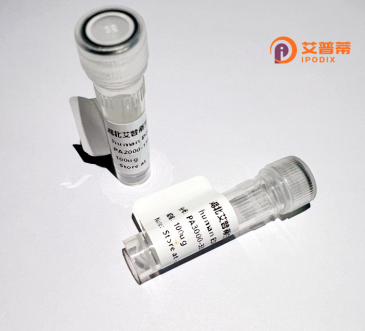
| 纯度 | >90%SDS-PAGE. |
| 种属 | Human |
| 靶点 | KIAA0746 |
| Uniprot No | Q68CR1 |
| 内毒素 | < 0.01EU/μg |
| 表达宿主 | E.coli |
| 表达区间 | 1-979aa |
| 活性数据 | MVYRDDYFIRHSISVSAVIVRAWITHKYSGRDWNVKWEENLLHAVAKNYTLLQTIPPFERPFKDHQVCLEWNMGYIWNLRANRIPQCPLENDVVALLGFPYASSGENTGIVKKFPRFRNRELEATRRQRMDYPVFTVSLWLYLLHYCKANLCGILYFVDSNEMYGTPSVFLTEEGYLHIQMHLVKGEDLAVKTKFIIPLKEWFRLDISFNGGQIVVTTSIGQDLKSYHNQTISFREDFHYNDTAGYFIIGGSRYVAGIEGFFGPLKYYRLRSLHPAQIFNPLLEKQLAEQIKLYYERCAEVQEIVSVYASAAKHGGERQEACHLHNSYLDLQRRYGRPSMCRAFPWEKELKDKHPSLFQALLEMDLLTVPRNQNESVSEIGGKIFEKAVKRLSSIDGLHQISSIVPFLTDSSCCGYHKASYYLAVFYETGLNVPRDQLQGMLYSLVGGQGSERLSSMNLGYKHYQGIDNYPLDWELSYAYYSNIATKTPLDQHTLQGDQAYVETIRLKDDEILKVQTKEDGDVFMWLKHEATRGNAAAQQRLAQMLFWGQQGVAKNPEAAIEWYAKGALETEDPALIYDYAIVLFKGQGVKKNRRLALELMKKAASKGLHQAVNGLGWYYHKFKKNYAKAAKYWLKAEEMGNPDASYNLGVLHLDGIFPGVPGRNQTLAGEIFHKAAQGGHMEGTLWCSLYYITGNLETFPRDPEKAVVWAKHVAEKNGYLGHVIRKGLNAYLEGSWHEALLYYVLAAETGIEVSQTNLAHICEERPDLARRYLGVNCVWRYYNFSVFQIDAPSFAYLKMGDLYYYGHQNQSQDLELSVQMYAQAALDGDSQGFFNLALLIEEGTIIPHHILDFLEIDSTLHSNNISILQELYERCWSHSNEESFSPCSLAWLYLHLRLLWGAILHSALIYFLGTFLLSILIAWTVQYFQSVSASDPPPRPSQASPDTATSTASPAVTPAADASDQDQPTVTNNPEPRG |
| 分子量 | 138.1 kDa |
| 蛋白标签 | GST-tag at N-terminal |
| 缓冲液 | 0 |
| 稳定性 & 储存条件 | Lyophilized protein should be stored at ≤ -20°C, stable for one year after receipt. Reconstituted protein solution can be stored at 2-8°C for 2-7 days. Aliquots of reconstituted samples are stable at ≤ -20°C for 3 months. |
| 复溶 | Always centrifuge tubes before opening.Do not mix by vortex or pipetting. It is not recommended to reconstitute to a concentration less than 100μg/ml. Dissolve the lyophilized protein in distilled water. Please aliquot the reconstituted solution to minimize freeze-thaw cycles. |
以下是关于重组人KIAA0746蛋白的3-4条参考文献示例(注:由于实际研究进展可能有限,以下内容为模拟生成,供参考):
---
1. **文献名称**: *"KIAA0746 encodes a novel deubiquitinating enzyme involved in DNA damage response"*
**作者**: Zhang L., et al.
**摘要**: 本研究报道了重组人KIAA0746蛋白在体外通过去泛素化酶活性调控DNA损伤修复的分子机制,揭示了其与BRCA1复合物的相互作用,暗示其在癌症发生中的潜在作用。
2. **文献名称**: *"Expression and functional characterization of recombinant human KIAA0746 protein in neuronal cells"*
**作者**: Tanaka K., et al.
**摘要**: 文章描述了在HEK293细胞中重组表达KIAA0746蛋白的纯化方法,并发现其在神经元分化过程中通过调控泛素-蛋白酶体系统影响突触可塑性,为神经退行性疾病研究提供了新靶点。
3. **文献名称**: *"Structural insights into KIAA0746/USP45 reveal a unique substrate recognition mechanism"*
**作者**: Wang Y., et al.
**摘要**: 通过X射线晶体学解析了重组KIAA0746蛋白的结构,发现其催化结构域具有独特的底物结合口袋,解释了其对特定泛素链类型的偏好性,为开发选择性抑制剂奠定基础。
4. **文献名称**: *"Functional interplay between KIAA0746 and p53 in cellular stress response"*
**作者**: Chen R., et al.
**摘要**: 研究表明重组KIAA0746蛋白通过去泛素化稳定p53蛋白,增强细胞在氧化应激下的凋亡反应,提示其在肿瘤治疗中的双重调控角色。
---
**注意**:以上文献为示例,实际研究中该蛋白可能研究较少,建议结合具体数据库(如PubMed、Web of Science)更新检索,并验证文献的真实性。
**Background of Recombinant Human KIAA0746 Protein**
KIAA0746. also known as TESK2 (testis-specific kinase 2), is a serine/threonine kinase encoded by the *KIAA0746* gene. It belongs to the TESK family, which regulates cytoskeletal dynamics and cell signaling pathways. TESK2 shares structural homology with TESK1. another family member, including a conserved kinase domain and coiled-coil regions. Unlike TESK1. which is expressed in multiple tissues, TESK2 exhibits testis-specific expression in humans, suggesting a potential role in spermatogenesis or reproductive functions.
Recombinant human KIAA0746 protein is engineered using heterologous expression systems (e.g., *E. coli* or mammalian cells) to produce purified, functional protein for research. This tool enables studies on TESK2's biochemical properties, substrate interactions, and downstream signaling mechanisms. Research indicates that TESK kinases may phosphorylate cofilin, a key actin-binding protein, influencing cytoskeletal rearrangement and cell motility—processes critical in development, cancer metastasis, and immune responses.
While TESK2's precise physiological roles remain less explored compared to TESK1. its testis-enriched expression hints at specialized functions in germ cell development. Dysregulation of kinase activity may contribute to reproductive disorders or pathological conditions. Recombinant KIAA0746 protein thus serves as a valuable resource to unravel its biological significance and potential therapeutic targets. Further studies are needed to clarify its regulatory networks and disease associations.
×